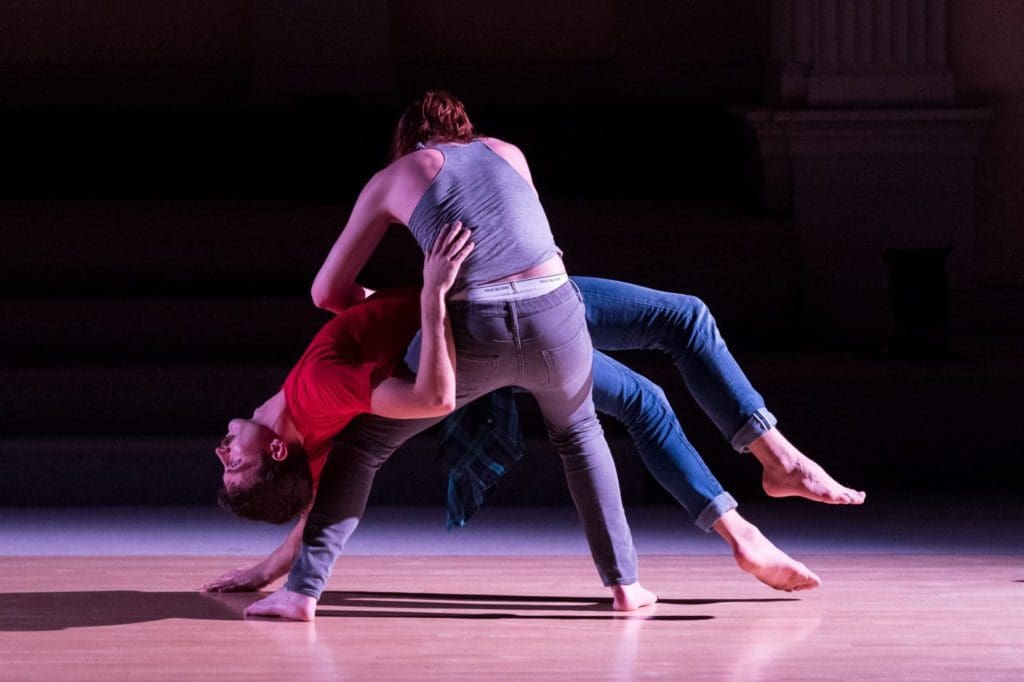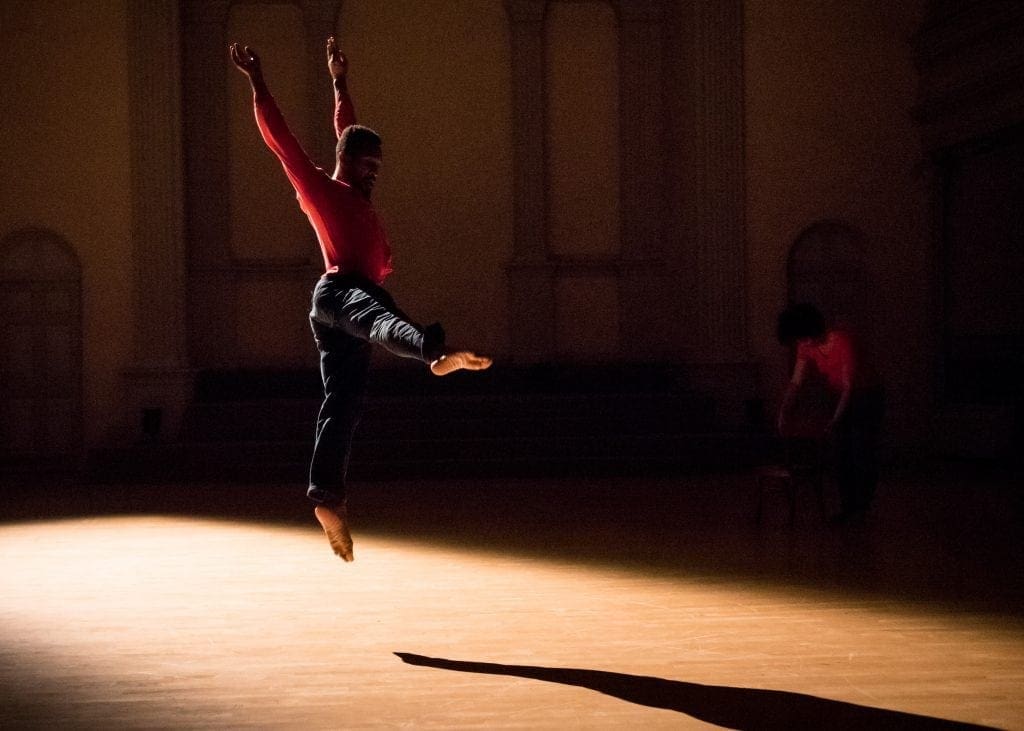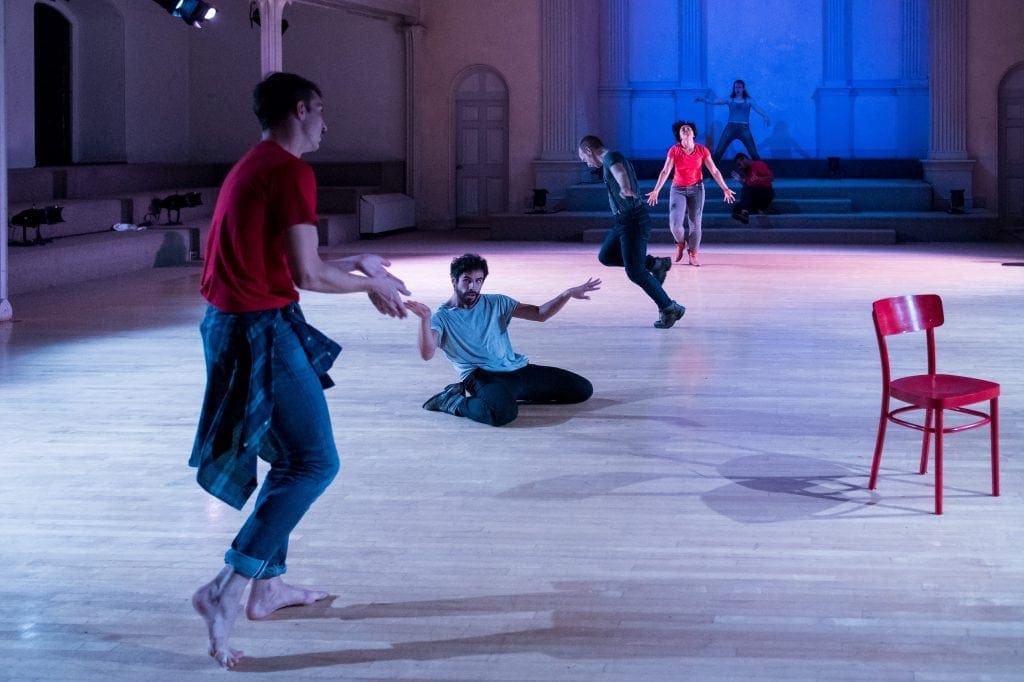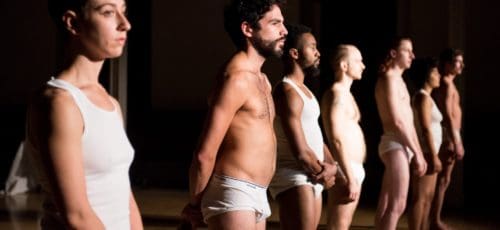Scenes from a Life: Miguel Gutierrez on Discovering John Bernd’s Enduring Influence
Miguel Gutierrez initially joined collaborator Ishmael Houston-Jones in a limited role on a project reconfiguring dance by experimental East Village choreographer John Bernd. Watching videos of Bernd’s shows and reading about his work, Gutierrez quickly realized he needed to immerse himself in the project. The resulting Fringe Festival show Variations on Themes from Lost and Found: Scenes from a Life and other works by John Bernd, mashes up works by the influential choreographer, whose work flourished during the era of experimental dance in 1980s New York, and whose life was tragically taken by AIDS in 1988.
Running this weekend, with performances on Friday, Saturday, and Sunday, the highly anticipated show combines Bernd’s last seven pieces into a new dance performance that honors the choreographer’s memory and imagines what dance would look like today if the community had not been decimated by the deadly AIDS epidemic. As a contemporary Brooklyn artist and performer who creates dance-based performance, music, and poetry, Gutierrez witnesses the lasting impact of Bernd’s multidisciplinary work on dance today and on his own work. He spoke to FringeArts about finding roots in the past and continuing Bernd’s legacy into the future.
FringeArts: What was your introduction to the work of John Bernd?
Miguel Gutierrez: I’d only known about John Bernd peripherally for the many years I had been in New York. It wasn’t until Ishmael asked me to help him out with this project that I sat down and watched his pieces. Within five minutes I knew I wanted to be involved in whatever way I could with this project.
FringeArts: What appeals to you about his work?
Miguel Gutierrez: What I identified with immediately was the spirituality, love of dancing, queer intimacy, and rawness. Like people are able to spot each other, even across expanses of time. I saw desire and contemplation and thoughtfulness and exploration. I could FEEL it, even in a shitty rehearsal video.
He dealt directly with themes of intimacy, betrayal and caregiving between queer men and women. He was obsessed with—haunted by—the image of the open road, mountains, temples; he drew these images and slides of them were projected in his work. He made his own music and songs, which is something I could directly relate to because I do the same for my work. In essence, I was discovering an ancestor that I never knew I had.
FringeArts: What do you see as his legacy?
Miguel Gutierrez: So many people who worked with him were people who I have worked with or have encountered in the community—Ishmael most obviously, but also Yvonne Meier, Jennifer Monson, Anne Iobst, K.J. Holmes, Stephanie Skura. I was sort of shocked to see all of these people in his work and to realize that, either directly or indirectly, his influence had made it to me, partially shaped me.
I think his legacy was already living in these artists who worked with him, but working on this project, I see him as one of thousands upon thousands of artists and just people who we lost to the negligence of the U.S. government during the height of the AIDS epidemic. I see him as one of the voices who was essentially silenced because of this negligence. But artistically I see his legacy as one of survival, resistance, ambition, persistence, truth telling, queerness, compassion, thoughtfulness and profound care and love, in terms of thematics, and interdisciplinarity in terms of form.
FringeArts: What was going on in your life or career when you became involved in this project?
Miguel Gutierrez: In 2016 I was taking a break, or sabbatical, from making my own work. I decided that I wouldn’t make my own work, or apply for any grants for anything. I needed a break from the rat race of producing, so to speak. I was initially totally resistant to getting into ANY kind of process – Ishmael kept trying to get me involved and I was like “I’m not getting into a studio process this year, bitch!” Ha. But like I said, I watched some of the videos and got obsessed immediately.
I think that for me, going deep into John’s work affirmed or nuanced a feeling that I was having about the strangeness of ambition and careerism. Like, what the hell do we do this all for? And for whom? From one of his letters to Sally Banes from around 1981 it is really clear to me that John was very ambitious. He wanted to get his work out there and he wanted to tour. He had a travel case made for the little red chair that he incorporated into all of his shows for god’s sakes. And yet he died so young. I think learning about him helped me put my frustrations about my career into perspective, helped tap me back into gratitude and appreciation for the opportunities that I’ve had, but also reminded me that at the heart of any artistic enterprise, what is most important is the intimacy you develop with your work and with the people who help you realize it.
FringeArts: How do you frame and present Bernd’s work in this work?
Miguel Gutierrez: Early on, we knew we wanted to have a cast that was diverse in presentation, if somewhat uniform in terms of age range. And John made such different kinds of pieces – solos, duets, group works, with mixtures of choreography and improvisation.
We looked at the pieces John made between 1981, right after his first hospital stay (where the doctors still didn’t understand what was going on with him physically) up until 1988 when he died. I think Ishmael and I were basically just intuitive about the themes or movement motifs that kept coming up and so we selected those sections and reconstructed them. This was a combination of choreographed movement material, song, text, and improvisation.
From there it was just about experimenting with structures and arrangement of the sections. I am kind of a structure nerd so I love thinking about this stuff. Ishmael has an incredible way of making decisions that are beautifully illogical and ultimately more surprising and unpredictable. So that was a good fit. I think we understood early on that we weren’t doing a reconstruction in the traditional sense, but rather a re-imagining. I kept saying throughout the process to the dancers—this is so intense because we know how the story ends, in terms of what happened to John. But obviously in the moment of its original construction and performing, his work was his anchor, I think. So we kept trying to find ways to foreground that.
FringeArts: What were you discussing with Ishmael and dancers during the creation and rehearsal process?
Miguel Gutierrez: During the initial residency for the project we watched all three of John’s pieces called Lost and Found: Scenes from a Life (Parts 1 – 3). After we watched a piece we would just talk about what we saw and Ishmael would talk about the context of the time, telling more stories about John and the East Village scene and the scene around P.S. 122. We also had the zine that John’s caregivers had made in 1998 about the experience of taking care of John as well as reflections on just how they felt about him. The dancers read this and we talked about it. They also ended up going to the Performing Arts Library to watch John’s incredible solo from 1981 – Surviving Love and Death.
Basically they were just very open to getting as much information as possible about John and the context in which he was making work. Obviously it is a very different time now than it was in the early to mid 80s. There’s no way you can re-construct that. But there are parallels in the way the dancers are living – their artistic lives exist within the precarity of contemporary capitalism and the ridiculousness of trying to survive as an artist now. They also deeply understand the importance and strength of queer kinship – this is something that still rings true.
FringeArts: What should the audience know coming into this piece to fully open themselves up to it?
Miguel Gutierrez: I think the piece, true to John’s spirit, invites a welcoming viewing experience…I don’t think there’s anything particular they need to know beforehand. Generally I just think it’s good to come to a show well rested and fed.
—Alyssa Kerper & Christopher Munden
What: Variations on Themes from Lost and Found: Scenes from a Life and other works by John Bernd
When: September 14–16, 2018
Where: Christ Church Neighborhood House, 20 North American Street
Cost: $15–$35
Created by Ishmael Houston-Jones and Miguel Gutierrez
FringeArts.com/8056
Photos by Ian Douglas




